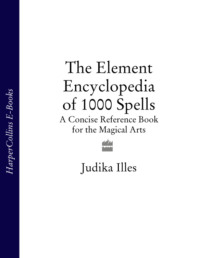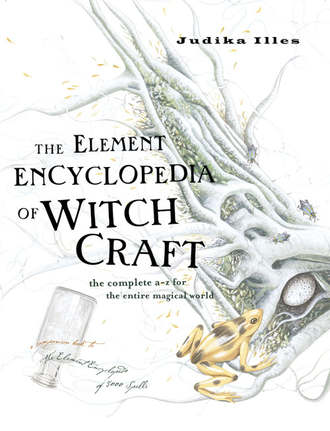
Полная версия
The Element Encyclopedia of Witchcraft: The Complete A–Z for the Entire Magical World



All of these animals will be encountered when we explore those animals most associated with witchcraft (see ANIMALS).
The basis of the “fertility cult” is that life is beautiful and precious. Earth is wonderful, sacred; there is no better place to be. Physical expression of life is sacred and worthy of regeneration and reproduction. The physical universe—Earth and her living waters, the moon, other animals, plants, spiritual entities, the very human body—all are linked in a holistic web. In the best of all possible worlds, all powers within this universe are in balance, with good health, the potential for new life as desired, happiness, and joy as the result.
It’s not all positive, however. What of those who are barren, who can’t or won’t conceive? What if your individual goals are different than those of the community? What if your vision for your future, for whatever reason, doesn’t involve reproduction? If involuntary infertility is linked to spiritual imbalance, what is the perceived impact of the individual on the community? The barren woman may be perceived as dangerous to the common good, particularly in societies where agriculture and individual fertility are intensely linked.
Because women are linked to the moon, to Earth, seeds, and growth, and because those affinities aren’t perceived as only traveling one-way, an inability or unwillingness to conceive is often understood as adversely affecting the harvest, and hence everyone’s ability to eat. A woman’s infertility may be contagious or emblematic of some kind of dangerous imbalance or spiritual violation.
The healer/shaman/witch who can remedy this situation, producing miracles, stimulating conception whether through herbalism, negotiation with the spirits or any other magical process is a valued, priceless member of society. She is also feared: if she can increase odds of pregnancy, she probably has the power to decrease or eliminate it too. Maybe someone’s infertility is her fault.
Of course, all of this postulates that fertility, sex, human bodies, existence on the Earthly plane is a good thing, and thus worthy and desirous of being reproduced. This, however, isn’t a view shared by all.
Dualism
Of course, there’s more than one way of making sense of the universe. The perspective of the “fertility cult” understands the world as filled with magical forces that must be balanced and carefully manipulated to achieve harmony. If any of these forces is pushed too far in any direction, balance is shattered and disharmony reigns; growth (fertility, prosperity, abundance) stagnates or stops.
But what if you’re seeing it all wrong? What if those forces cannot be balanced but are diametrically opposed? What if these forces are really in mortal combat? What if the perception that making love is sacred is only an illusion and instead what is really being made is spiritual warfare? What if the magic unification of two complementary forces (male/female) is impossible and the only possible outcome of a meeting between these two opposing forces is victory for one side, submission for the other?
What if that yin-yang symbol depicting merger and complementary coexistence of opposing forces is incorrect? Maybe the true diagram that maps existence is linear: two columns arranged like a balance sheet, or like a chessboard with opposing pieces lined up on either end.
No longer a spectrum, the material word can be organized into oppositional pairs:
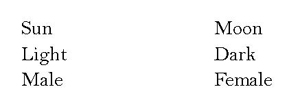
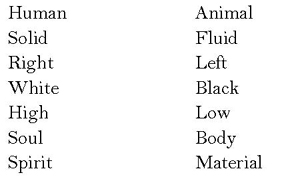
Contrasting powers are no longer understood as complementary forces arranged on a spectrum; instead they are oppositional and no spectrum exists. There are no gray areas. Boundaries between oppositional forces are clear, distinct, and absolute. (In other words, no little white dot inside the black side or black dot within the white as in the yin-yang symbol.) Each opposing force is mutually exclusive of the other.
Every item on one side of the balance sheet is linked to every other item on its side and opposed to all items on the other. Each item on one side shares an essence with the others on its side; they serve the same master. The categories on this world balance sheet not only include physical observations but perceived moral, value judgments as well:
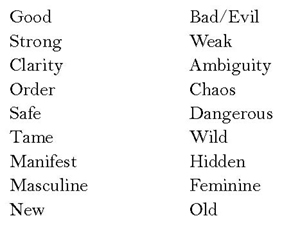
Because “evil” is now understood as absolutely distinct from “good,” serious theological concerns arise as to the origins of evil, where it comes from, who’s responsible and how it may be eradicated, once and for all. Questions as to who is leading each side, exactly who’s responsible and in charge, become crucial.
Those concerns aren’t relevant to the old shamanic/fertility cult perspective. It doesn’t figure value judgments into the equation, at least not on an abstract basis. Any power (light, dark, masculine, feminine) may be used for good or evil; it is how it is used that affects the outcome. The power in itself is neutral. This is absolutely not the case with what will become known as “dualism.”
I’ve given a very, very, very simplistic explanation of a profound disagreement in perspective that ultimately had earth-shattering, world-altering consequences, not least on spirituality, witchcraft, and women’s roles. How we treat women, children, the Earth, our natural environment, plants, and animals all derive from this dichotomy. At its most basic, the difference between the two perspectives stems from a very simple root: some people tolerate ambiguity (and may even enjoy it) while others do not.
The dualist perspective stems from very human emotions: fear and anxiety, a desire for security, clarity and order, firm unwavering boundaries, a need to categorize. Look at the balance sheet: order and clarity emerge on the same balance side as good, safe, and light. Male is on that side, too, as is right, high, and white. That old shamanic swirling world of invisible, merging, ambiguous powers is chaotic, fluid, and messy. It finds itself on the balance sheet on the same side as evil, dark, dangerous, wild, and female.
The word “dualism” is derived from the Latin duo, “two.” In English, the name also contains a pun: the two sides on that eternal chessboard duel with each other. That’s the most basic explanation of “dualism” although that word, like “witchcraft” has come to mean many things to many people. (In psychological and literary circles, as opposed to religious and historical ones, “dualism” is often used to discuss philosophers like Kant, Heidegger, and Descartes.) However, at its most basic, the term is used to denote a theological system that explains the universe as the outcome of two eternally opposed and conflicting principles, such as good and evil. There is no way to balance these forces because balance implies compromise and compromise strengthens evil. Everything in the universe can be classified on one side or the other. If classification isn’t clear, if something is ambiguous, then it’s quite obvious on which side of the balance sheet that something belongs.
In the dualist view, soul and body are distinct, and potentially in serious conflict. There’s only one of each and by nature they are out of balance. Too much attention to the finite body (and for extreme dualists, any attention) only places the immortal soul in danger. To strengthen the side of good, the perishable physical body must be sublimated, perhaps even mortified, and the soul nourished. Immortality is achieved through the survival and salvation of the soul.
On the other hand, sometimes these perspectives of the world are two sides of a single coin, like seeing the same glass as either half-full or half-empty. For instance, because women bring forth new humans from their own bodies and can provide nourishment from those bodies, and because parallels are clearly observed between women’s bodies and such physical phenomena as lunar phases and tides, in the shamanic/fertility cult perspective, women are perceived as embodying divine energy. This is because those lunar phases, nature, the whole physical world are all understood to be sacred.
From the dualist perspective, however, those very same observations of women, their reproductive ability, their associations with the dark depths of night and ocean, all indicate women’s powerful affinity with the physical world, which is affiliated with the evil side of the universal balance sheet, hence turning her into a danger zone for men’s immortal souls.
It is hard to conceive of a philosophy that has had greater worldwide impact than dualism. It has infiltrated virtually every corner of Earth, its roots so deep that they permeate our very languages. Without an understanding and awareness of dualism, you cannot understand the fear, revulsion, and/or ambivalence so many feel towards witchcraft. Because of this it is worth our while to take a brief tour through the history of dualism.
Its birthplace seems to have been in Persia, in what is now modern Iran, from whence it spread through the Middle East, the Mediterranean and beyond. Dates vary as to when Zoroaster (Zarathusra) was born in Iran. Conservative Zoroastrians, members of the religion founded on his teachings, suggest 6000 BCE. Historians generally suggest sometime between 1500 and 1000 BCE. Previously, Iranian religion had been similar to that of polytheistic Mesopotamia and the pagan Middle East. Zoroaster preached a new faith with a new perspective. Initially he was attacked for his ideas, but eventually he found favor with the king. Zoroastrianism became the state religion and remained so until the Islamic jihad arrived in Persia in 650 CE. Many Zoroastrians fled to India where a community remains, as they do in Iran and elsewhere.
Although these facts may be unfamiliar to most Western readers, elements of Zoroastrian religion will be familiar to many:




This vision of a world struggling between forces of good and evil permeates the philosophies and spiritual traditions known as “Gnosticism” as well.
In the most literal sense, gnosis refers to the knowledge or understanding (divine comprehension) that produces, or at least supports spiritual salvation. The Gnostic is saved when he personally sees the light and experiences epiphany.
There was never one unified Gnostic movement. Instead the term refers to a series of schools and teachers, emerging in strength during the first century CE, centered mainly in Egypt and Judea. There’s wide variety, a broad spectrum of beliefs held by the various Gnostic schools, and Pagan, Jewish, and Christian schools of Gnosticism exist. Eventually, Gnostic philosophy would exert a profound influence on mainstream Christianity.
Although there are many variations on the theme, a typical Gnostic vision goes something like this: despite religious propaganda to the contrary, the material world was not created by the highest, good God. A lower being formed the physical world but in the process, true divine sparks of light were trapped. Thus Earth is corrupt, tainted, or even possibly evil, but it contains sparks of godly, divine, trapped goodness that can potentially be nurtured, saved, freed, and redeemed. Human suffering derives from entrapment in this physical world, which is governed by an Evil Being who impersonates God and usurps His power.
Some ancient Gnostic Christians perceived that the creator of the physical world—the demi-urge in Gnostic-speak—was the God of the Old Testament. Christ was an emissary sent to bypass the demi-urge by the true God. Once the notion of the Trinity became established, incorporating the Father, Son, and Holy Ghost, however, this perception became problematic and was considered heretical.
To put it mildly, the early centuries of the Common Era were times of tremendous spiritual seeking. Back in Persia, dualist philosophy continued to evolve. In 216 CE, a man named Mani (Manes) was born near the Tigris River in Babylonia, modern Iraq but then part of the Persian Empire. He was an intensely restless spiritual pilgrim who traveled widely, seeking enlightenment. Born a Zoroastrian, he studied and experimented with Buddhism and Gnosticism and even converted to mainstream Christianity for a while.
No religion he encountered satisfied him, although he found truths in many. He perceived all of them as incomplete, so he decided to perfect them, proclaiming himself the messiah of a new faith, Manicheism, characterized by an intense dualist vision.
Mani was a prolific artist and writer, setting down his philosophy and vision in words and drawings that were preserved for centuries. His became an important faith, not only during his lifetime but also for many centuries afterwards, with communities of adherents from Persia to Spain to China. Manicheism, at one time, was considered to be among Christianity’s chief competitors. The Church perceived Manicheism as a great threat and actively campaigned against it for centuries. None of Mani’s drawings, and only fragments of his writings survive because they were systematically searched out and destroyed by the Roman Catholic Church.
Mani’s luck changed when a new Persian ruler devoted to Zoroastrianism came to power. As the story goes (and to be fair, the story derives from those as opposed to the Zoroastrian magi as they were to Mani) the magi perceived Mani as a competitor and pressured the king, Bahram I, to arrest and condemn him. Various reports exist of his death, every one of them horrific. Either he was crucified, or flayed alive, or beheaded with his head stuck on a pole for extended public display. His martyrdom, however, only increased his popularity among some believers and made his faith, with its martyred, possibly crucified messiah, even more of an alternative path to Christianity.
The mission of Manicheism is to entirely separate spiritual light from material darkness. If and when this process is complete, then the Kingdom of Darkness will be for ever defeated. A microcosm of this war is fought out within each human being as the soul struggles to break free from the corporal body, while simultaneously the corporal body, under the dominion of the Lord of Darkness, tempts and encourages backsliding. Each person must achieve individual salvation: each human is a battlefield for the forces of Light and Darkness. You must actively choose your side. Among the keys to achieving liberation of one’s spiritual essence is an unwavering, complete obedience to the Manichean Church.
Some people are closer to that goal than others. Persons on the verge of spiritual liberation were known as the Elect. The Elect led highly disciplined, ascetic lives, abstaining from sex because indulgence in sensual pleasures (sex for its own sake) strengthens the body at the expense of the soul, and because babies, the result of sex for reproduction, are but fresh prisons for entrapped sparks of light. Furthermore, those precious sparks of light may be contained within sperm, which should thus be protected from the moist, darkness of the womb.
The Elect maintained a strict vegetarian diet, with one exception. Saint Augustine (13 November 354–28 August 430), a Manichean for nine years prior to his conversion to Christianity, reports that the Elect ritually consumed a concoction of dough and semen, the theory being that the trapped sparks of light might be liberated if consumed by those on the brink of salvation themselves.
Saint Augustine, pillar of the Christian Church, was a spiritual seeker, too, who explored pagan paths and Manicheism before devoting himself to Christianity. Although he rejected much Manicheist doctrine, Augustine also introduced the Manichean world-view into conventional Christian thought. Among those doctrines rejected by Augustine is the notion that knowledge (gnosis) leads to liberation. In Augustine’s view, humans are too tainted by Original Sin to accomplish salvation either through knowledge or other individual effort. It can only be achieved through obedience to Christian doctrine, the shepherd guiding the flock. However, he did retain the basic Manichean distrust of matter and the material—especially regarding sex.
Augustine taught that Adam’s defiance of God (as stimulated by Eve) produced a state of unbalanced desire (concupiscence) which infects every sexual act with the possible exception of completely pleasure-free, mechanical intercourse solely for the purpose of reproduction within the clear, firm boundaries of lawful Christian marriage.
Dualism permeates world culture, human culture, and especially Western culture. Dualist influence so pervades the vocabulary of modern spirituality that we don’t consider what common words literally mean: redemption, salvation, liberation—from what? They derive from the dualist world-view:


Dualists are right: dualism and the fertility cult, shamanic or otherwise, are incompatible views. From the moment of its emergence, dualism has been on an intense, inevitable collision course with those celebrating the cult of fertility, who wish to revel in Earth rather than be saved from her. At their roots, they are genuinely two oppositional viewpoints, two ways of looking at, organizing, and understanding the world. On the dualist side, there is no room for tolerance because compromise means that you’ve assented to the power of the Lord of Darkness. Very frequently, dualists have categorized people they’ve encountered who have possessed a shamanic or fertility-cultish perspective as “witches.” The results for those thus categorized, whether in Europe, North America, Africa or elsewhere, have consistently been disastrous.
It’s very tempting to see the “fertility cult” as the ancestor of witchcraft and dualism as that of its opponents; that very temptation demonstrates why dualism can be so attractive. Real life, however, is rarely that black-and-white and that would be a simplistic vision that denies the complexity of witchcraft as well as world history.
There are very few places left on Earth that have not been influenced by both dualism and the more ancient shamanic/fertility cult. Most cultures blend these influences to varying degrees. Dualism even pervades the world of witchcraft. In those immortal words spoken by Glinda to Dorothy in The Wizard of Oz, “Are you a good witch or a bad witch?” Many, if asked whether they are a witch, answer affirmatively but stipulate that they are a “good” witch, as if whatever powers they possess can only be used for good, not possibly for ill. (This may make the self-identified witch more comfortable with her identity, however historically, this distinction has made no difference to dualist authority, who often perceive the “good” witch as even more dangerous than her evil sister. See WITCHCRAZE!)
Witchcraft, defined as magical practices, is seemingly a crucial human need. Like the Egyptians’ heka, it emerges whenever it is necessary to attempt to ward off those harsh blows of fate or maybe whenever there’s just not enough joy and fun around. Witchcraft exists everywhere in various forms, and is thus found in all kinds of communities possessing all sorts of philosophies. What differs is how witchcraft is perceived (by the witches as well as outsiders) and whether it operates secretly or openly.
Animals
Where would the witch be without her cat? That black dog over there—is that a stray roaming loose, a disguised witch on the prowl or a messenger for the goddess Hecate? And those flies buzzing around? Do they merely indicate the presence of food or do they hold deeper significance?
Around the world, specific animals are associated with witchcraft. In some societies, certain animals are so intrinsically identified with witchcraft that should you have a close association with one (or in an era of witchcraft hysteria, even a brushing acquaintance will do), there’ll be no need to ask whether you’re a witch; that very relationship defines you as one.
There is no creature, living, extinct, or mythical, that does not have its place among the magical powers of witchcraft. Each creature possesses its own magical powers, to be drawn upon by the human practitioner as needed. Elks, for instance, are invoked for romance; dragons to guard wealth. However, certain animals are specifically identified with witchcraft, whether as teachers of the art or because of relationships with witches. These are the animals that are featured in this section.
Animals closely identified with witchcraft are invariably also closely identified with sex, birth, death, secret wisdom, wild nature, and/or intensely radiant male or female reproductive energy, the potential for creation, and hence magic. What is a magic spell, after all, but the act of bringing something into existence?



